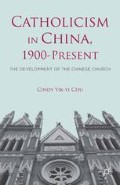Abstract
The Catholic Church in China today (encompassing government-approved and non-registered churches) faces challenges as diverse as the local communities it seeks to serve. The Sacred Heart Cathedral in Guangzhou presents a particularly interesting case of a g overnment-approved church serving multiple communities simultaneously. Balancing the needs of these communities—the Chinese Catholic community, expatriate and immigrant groups, particularly African migrants, the Church leadership—and the requirements of the local Chinese government, calls for sensitivity, adaptability, and a measure of openness to new forms of community participation. Due to the paradoxes and ambiguities in China’s religious policy, Catholic churches in China today enjoy relative autonomy from government control. However, underground church leaders continue to be arrested and persecuted from time to time. As a government-sanctioned or open church, the Sacred Heart Cathedral (also known as the Yide Lu church) has to struggle to maintain a balance between religious autonomy and loyalty to the party-state. This chapter examines how the recent influx of African migrants in the church has both highlighted and obscured some of the tensions in church-government relations.
This project was generously funded by the Hong Kong Research Grant Council (HKBU 245512). I also want to thank Kelechi Nwadike for his wonderful research assistance.
Access this chapter
Tax calculation will be finalised at checkout
Purchases are for personal use only
Preview
Unable to display preview. Download preview PDF.
Notes
Adams Bodomo, Africans in China: A Sociocultural Study and Its Implications on Africa-China Relations (Amhert, NY: Cambria Press, 2012); Evan Osnos, “The Promised Land: Letter from China,” New Yorker, February 9, 2009, pp. 50–55.
Zhigang Li, J. C. Ma, and Desheng Xue, “An African Enclave in China: The Making of a New Transnational Urban Space,” Eurasian Geography and Economics vol. 50, no. 6 (2009), pp. 699–719;
Heidi Østbø Haugen, “Nigerians in China: A Second State of Immobility,” International Migration vol. 50, no. 2 (2012), pp. 65–80;
Yang Yang, “African Traders in Guangzhou: Routes, Reasons, Profits, Dreams,” in Globalization from Below: The World’s Other Economy, ed. Mathews et al. (London: Routledge, 2012), pp. 154–170.
Zhigang Li, Desheng Xue, Feng Du, and Ying Zhu, “The Local Response of Transnational Social Space under Globalization in Urban China: A Case Study of an African Enclave in Guangzhou,” Geographical Research vol. 28, no. 4 (2009), pp. 920–932. For media coverage of Africans in Guangzhou, see Jinghui Zhen, “Feizhou heiren zai guangzhou” (“Black Africans in Guangzhou”), Nanfengchuang (For the Public Good) no. 19 (2009), pp. 56–59; Xuedong Ke and Anna Du, “Guangzhou heiren ‘buluo’ quan jilu” (“A Full Record of ‘Black Tribes’ in Guangzhou”), Guangzhou Daily, December 13, 2007.
Zhigang Li, Michal Lyons, and Alison Brown, “China’s ‘Chocolate City’: An Ethnic Enclave in a Changing Landscape,” African Diaspora vol. 5, no.1 (2012), pp. 51–72.
Kim Knibbe, “‘We Did Not Come Here as Tenants, But as Landlords’: Nigerian Pentecostals and the Power of Maps,” African Diaspora vol. 2, no. 2 (2009), pp. 133–158;
Rijk Van Dijk, “Cities and the Social Construction of Hot Spots: Rescaling, Ghanaian Migrants, and the Fragmentation of Urban Spaces,” in Locating Migration: Rescaling Cities and Migrants, ed. Nina Glick Schiller and Ayse Çaglar (Ithaca, NY: Cornell University Press, 2011), pp. 104–122;
Marten van der Meulen, “The Continuing Importance of the Local: African Churches and the Search for Worship Space in Amsterdam,” African Diaspora vol. 2, no. 2 (2009), pp. 159–181.
There might be a structural reason as well since the Chinese authority has been trying hard to insulate Christians in China from foreign influence; for more detail, see Cindy Yik-yi Chu, The Catholic Church in China: 1978 to the Present (New York: Palgrave Macmillan, 2012).
Frank N. Pieke, “Immigrant China,” Modern China vol. 38, no. 1 (2012), pp. 40–77.
Knibbe, “‘We Did Not Come Here as Tenants, But as Landlords’”; Kristine Krause, “Cosmopolitan Charismatics? Transnational Ways of Belonging and Cosmopolitan Moments in the Religious Practice of New Mission Churches,” Ethnic and Racial Studies vol. 34, no. 3 (2011), pp. 419–435.
Allan Anderson, An Introduction to Pentecostalism (Cambridge, UK: Cambridge University Press, 2004); Knibbe, “‘We Did Not Come Here as Tenants, But as Landlords’.”
Editor information
Copyright information
© 2014 Cindy Yik-yi Chu
About this chapter
Cite this chapter
Lan, S. (2014). The Catholic Church’s Role in the African Diaspora in Guangzhou, China. In: Chu, C.Yy. (eds) Catholicism in China, 1900-Present. Palgrave Macmillan, New York. https://doi.org/10.1057/9781137353658_12
Download citation
DOI: https://doi.org/10.1057/9781137353658_12
Publisher Name: Palgrave Macmillan, New York
Print ISBN: 978-1-349-47238-3
Online ISBN: 978-1-137-35365-8
eBook Packages: Palgrave Religion & Philosophy CollectionPhilosophy and Religion (R0)

